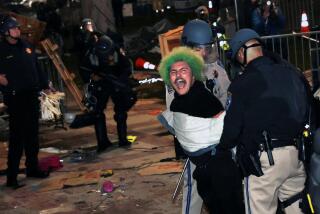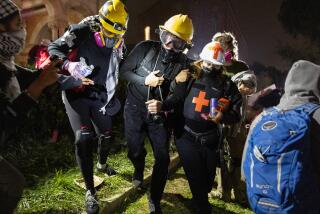Police Dropping ‘Nonlethal’ Beanbags as Too Dangerous
- Share via
Nearly a decade after small, square beanbags fired from shotguns emerged as the “nonlethal” ammunition of choice, police departments nationwide are abandoning them after finding that they can be dangerously inaccurate and deadlier than manufacturers claimed.
The devices, the size of tea bags and made of tough fabric filled with lead shot, are supposed to bounce off their targets, allowing police officers to stop a potentially dangerous person without causing major injuries. But officials cite examples of beanbags penetrating deep into the body, causing serious internal injuries.
Emergency room doctors in Los Angeles last year warned hospitals across the country about the dangers of police beanbags. And Los Angeles police, after extensive tests prompted by the death of a mentally ill man hit by a bag, concluded that the rounds frequently failed to work as designed.
In what is shaping up as a legal test case for nonlethal weapons, Huntington Beach is suing the country’s largest beanbag manufacturer, claiming that the company failed to properly warn police about the dangers of the rounds. The suit stems from an incident in which officers nearly killed a suspect with beanbags that ripped deep into the man’s chest.
The problems underscore the continued difficulty police agencies face in finding weapons that can stop people without killing them.
Beanbags and plastic bullets have killed 12 people in the United States and Canada, according to surveys by law enforcement weapons experts who track cases as far back as the 1970s. Dozens more people have suffered injuries ranging from ruptured eyeballs and damaged spleens to broken bones.
Federal testing and industry standards exist for police bullets, but no standards exist in the world of nonlethal weapons. A project launched by the federal government 10 years ago to develop safety standards has yet to yield any.
“There are some [weapons] out there that are clearly not as less-than-lethal as they claim,” said David Boyd, a director with the National Institute of Justice, a branch of the U.S. Department of Justice. “What we lack right now is an objective way of telling which ones they are.”
Beanbag manufacturers defend the accuracy and safety record of their products, saying the ammunitions should only bruise or graze a target when police officers use them correctly. They maintain that many of the deaths and severe injuries have been caused when officers fire from too close or aim for sensitive areas.
“Beanbags, if used appropriately, are very effective,” said Michael Keith, president of MK Ballistic Systems. “There are probably several thousand lives in this country that have been saved as a result of the beanbags.”
Capt. Sid Heal isn’t used to missing a target, but the Los Angeles County sheriff’s marksman watched helplessly one recent morning as he fired a shotgun filled with beanbags.
The first beanbag fell well short of its mark. A second missed the center of the target by a foot.
“There you go,” he said. “Nobody can tell what they’ll do. They’re like a leaf in the wind.”
Heal has squirted sticky foam at Marines in Somalia and zapped sheriff’s deputies with electric Tasers at home. He has blasted stun grenades into buildings and pumped gelatin blocks full of plastic bullets.
As police experiment with ways to knock people down without hurting them, arms makers have flooded the market with weapons they say are less likely to be lethal. Heal has tried virtually all of them.
At the range, he strode up to a row of paper targets hanging 75 feet away. Inspecting his target, he pointed to narrow holes that beanbags had torn in the paper, a sign that the rounds had not worked properly.
Beanbags are designed to unfurl when fired, slapping a suspect with their open face. But Heal and other ballistics experts have discovered that the rounds often strike on an edge or while still curled up, turning them into sometimes deadly projectiles.
‘Fail Catastrophically’
“When they fail, they fail catastrophically,” Heal said. “We’re in the blunderbuss age of less-lethal weapons.”
The concern over safety is one reason the square beanbags are falling out of favor. Last year, Defense Technologies, the country’s largest maker of beanbags, sold them to 288 agencies, down from 604 the year before.
Just a few years ago, beanbags were the most popular of all nonlethal ammunition, winning praise from civil rights advocates as a humane way of scattering unruly crowds and restraining violent or suicidal suspects.
In Los Angeles and other big cities, police credited beanbags with helping reduce officer-involved shootings by 50% in the last five years. LAPD officers used beanbags 68 times last year, according to police reports.
At Los Angeles County-USC Medical Center, doctors have had a very different experience.
On the 13th floor, behind clanging steel doors and armed guards, lies a bleak ward devoted to treating jail inmates and those injured while being arrested.
Six years ago, hospital officials decided to track beanbag injuries. They assigned the task to Dr. Dirk de Brito, an intense 35-year-old intern. Over the next four years, he reviewed 40 injuries treated at County-USC stemming from incidents involving the LAPD or Sheriff’s Department. He discovered that beanbags were capable of breaking bones, bruising internal organs and ripping through skin.
“Because this is a new weapon, a substantial part of the human testing of this has been on the streets of L.A.,” he said.
One evening, two LAPD officers escorted a 37-year-old inmate into the jail ward. They told De Brito that they shot the man when he ran at them with a machete. They said they fired beanbags to avoid hurting him.
At first glance, nothing looked seriously wrong. But De Brito decided to check the man’s forearm. The impact of a beanbag, he found, had crushed the arm so severely that blood couldn’t flow. Blood pressure inside the limb was growing dangerously high. De Brito grabbed a surgeon, who sliced open the inmate’s arm to relieve the pressure and save his limb.
With some injuries, officers admitted that they had shot beanbags just a few feet from a suspect, far closer than manufacturers recommend, says the most comprehensive medical report yet on beanbag injuries, co-written last fall by De Brito. In other cases, the officers said they fired from a safe distance.
The report cites the man who needed 100 pieces of lead shot removed from his chest. The teenager who had a beanbag smash into his skull and lodge behind his eye. The 32-year-old man struck so hard that his spleen ruptured.
Lives Saved
“I know these saved lives,” De Brito said, “but I wish the officers had something better.”
In September 1999, LAPD officers in Van Nuys tried to calm a 29-year-old man, Daniel Antonio Hernandez, who was yelling in the street and talking incoherently. According to the officers, Hernandez picked up a metal stake and rushed at them. One of the officers fired a beanbag shotgun. One round penetrated Hernandez’s jaw. Another struck a medallion that hung from his neck and pierced his chest, tearing into a lung and killing him.
The officers said the shots were fired from a relatively safe distance. Supervisors were skeptical at first. Doreen Hudson, a veteran LAPD criminalist, helped launch tests to see if the officers could be telling the truth.
During months of testing, researchers said, the beanbags regularly struck targets while curled up or on their edge. In one set of tests, fewer than 10% of the rounds opened in flight.
“It will hit on its edge and cut you like a knife,” Hudson said. “Nobody wants to pull the trigger and not know what the outcome is going to be.”
New Beanbag Style
In the last two years, hundreds of police agencies have changed to a new type of beanbag that resembles a sock filled with lead shot--a move that the LAPD is considering.
The sock-style rounds lack the sharp edges of square bags, and ballistics experts say they are much less likely to cause serious injuries. But they have killed three people in the last two years, including a 48-year-old Long Beach woman who was hit so hard that the impact tore the wall of her heart.
Most beanbag manufacturers market the sock-style weapons as more accurate but maintain that the square rounds remain a safe option.
At Defense Technologies’ parent company, Armor Holdings Inc., based in Florida, officials said they are “skeptical of the claim” that tests show the square bags to be unsafe. The company, they said, conducted extensive tests to ensure that the product was safe before selling it.
The bags, they added, have been shot at people hundreds of times without problems. And when fired at safe distances, they have inflicted little more than a welt or large bruise, said Steve Croskrey, president and chief executive of Armor’s product division.
Huntington Beach police say otherwise.
Attorneys representing the city contend that the company’s beanbags nearly killed James Marvin Davis when officers tried to take him into custody.
The January 1999 incident began with a 911 call by Davis’ fiancee, who complained that he was drunk and acting abusive. Officers ordered Davis out of his house. Davis, then 56, refused and stood in his doorway screaming.
Believing that he had a gun, an officer grabbed a beanbag shotgun and opened fire. “I felt thump, thump, thump to my chest. It felt like I was being punched,” Davis recalled. “I had blood running down my arms.... I remember shouting, ‘Look what you’ve done to me!’”
Three rounds bored through his chest, breaking two ribs and severing an artery. The bags had to be removed by surgeons.
While Davis recovered, police investigated the shooting. Police reports of the shooting scene suggest that the beanbags were fired from about 30 feet--a range that company literature deemed safe.
Davis is suing the department, which in turn has sued the manufacturer. The department alleges that the company failed to warn police adequately about the dangers of the bags. The company denies any wrongdoing.
Testing Ammunition
In the largest test of nonlethal weapons to date, researchers from Pennsylvania State University, who worked with the Los Angeles County Sheriff’s Department, examined 100 types of rubber, wood and foam bullets, along with beanbags and other ammunition.
A quarter of the rounds didn’t hit a man-sized target when fired from 75 feet. Many also failed quality control tests. When a first shot would leave the gun barrel too slowly, a second round would explode from the muzzle at deadly speed.
“The disparity ranged from completely ineffective to tragic,” said Heal, the sheriff’s captain.
Many in law enforcement believe that these problems could have been prevented had the federal government tested the beanbags the same way it evaluates other types of ammunition and equipment used by law enforcement.
At the National Institute of Justice, scientists blame funding woes for their slow progress on safety evaluations. This year, $2.5 million has been allocated to speed up work, they say.
More to Read
Sign up for Essential California
The most important California stories and recommendations in your inbox every morning.
You may occasionally receive promotional content from the Los Angeles Times.











